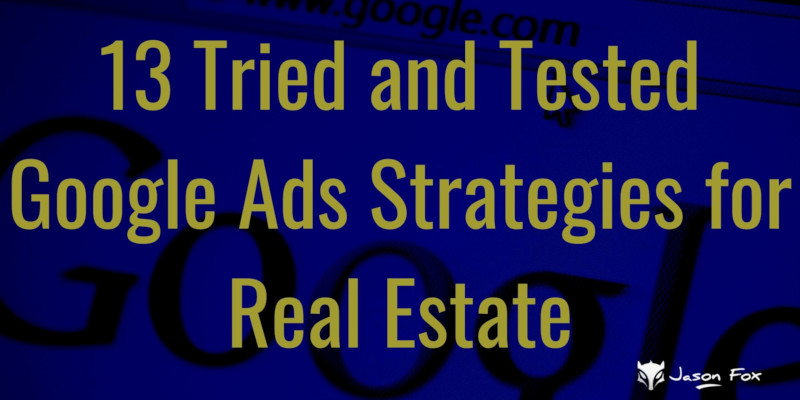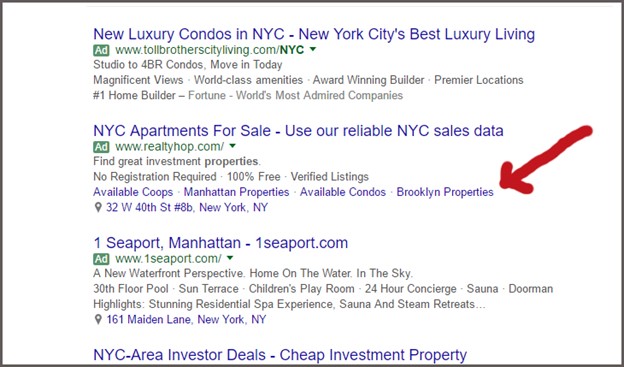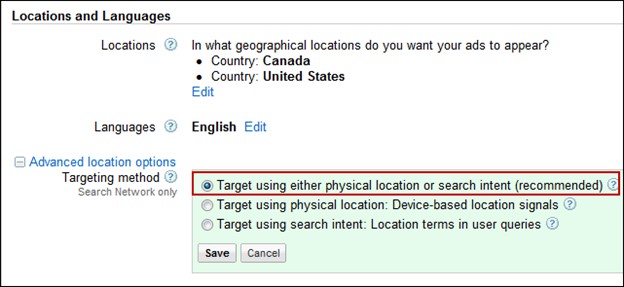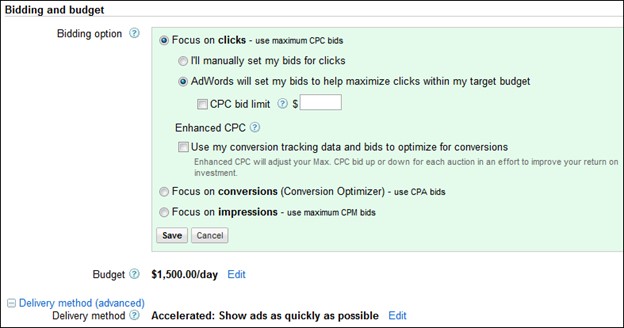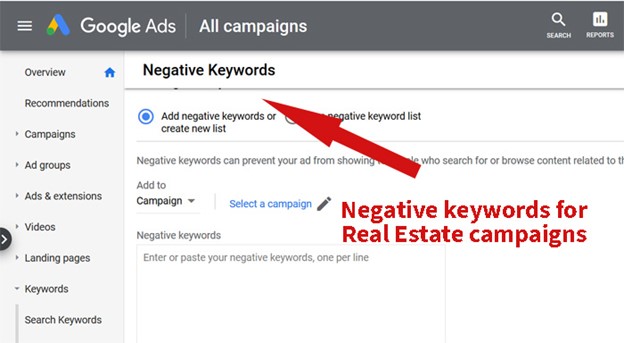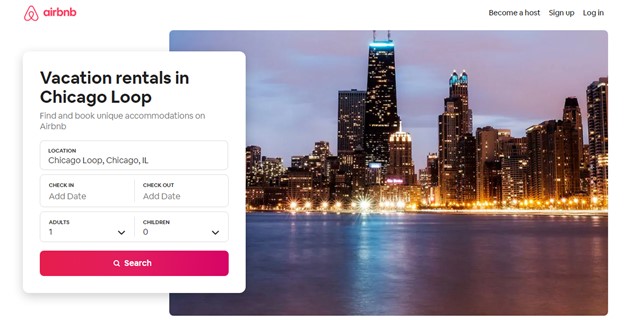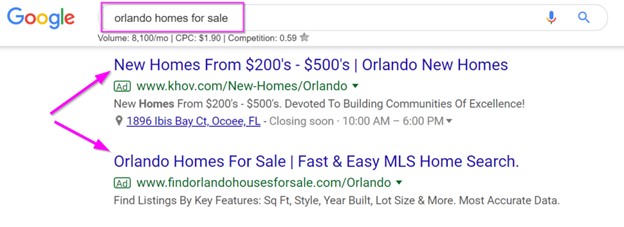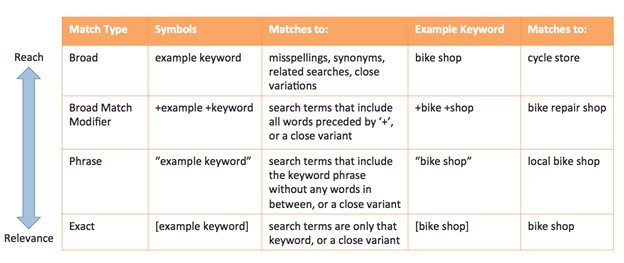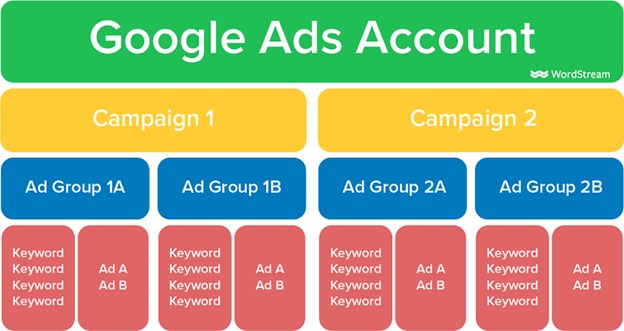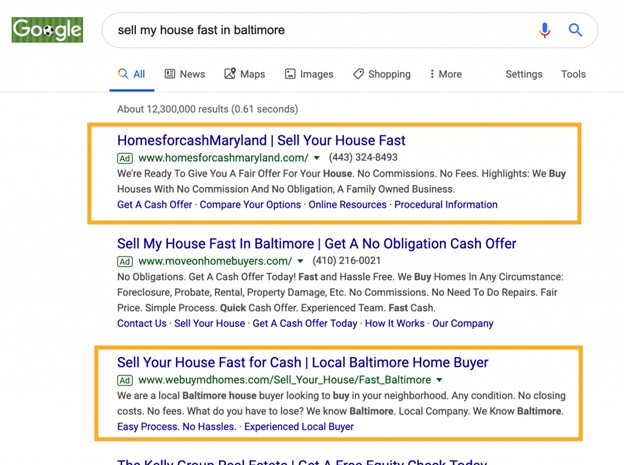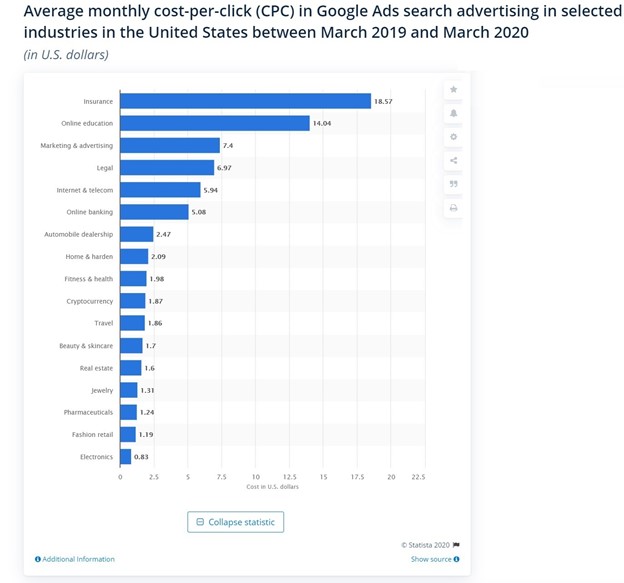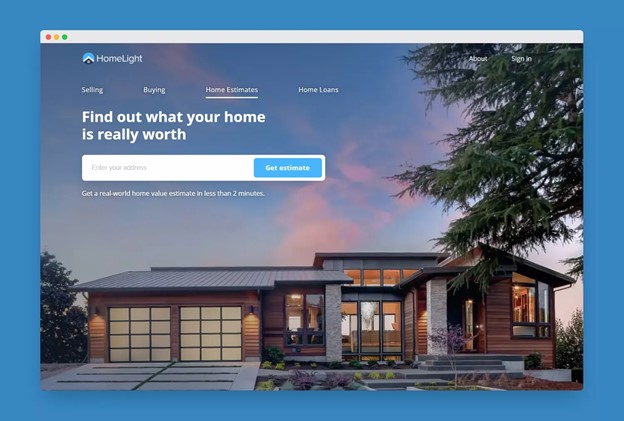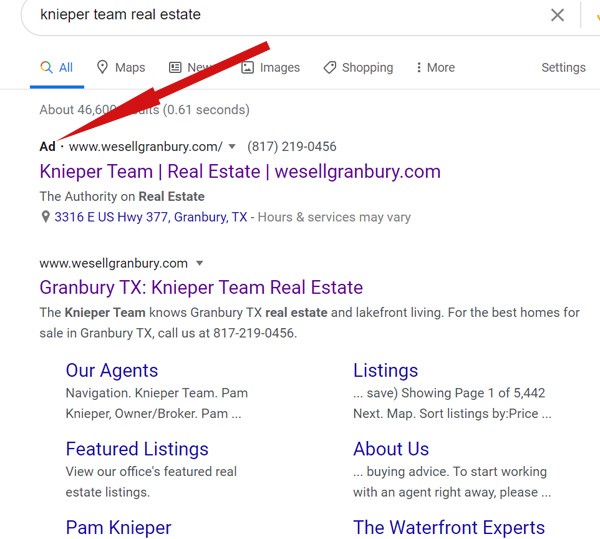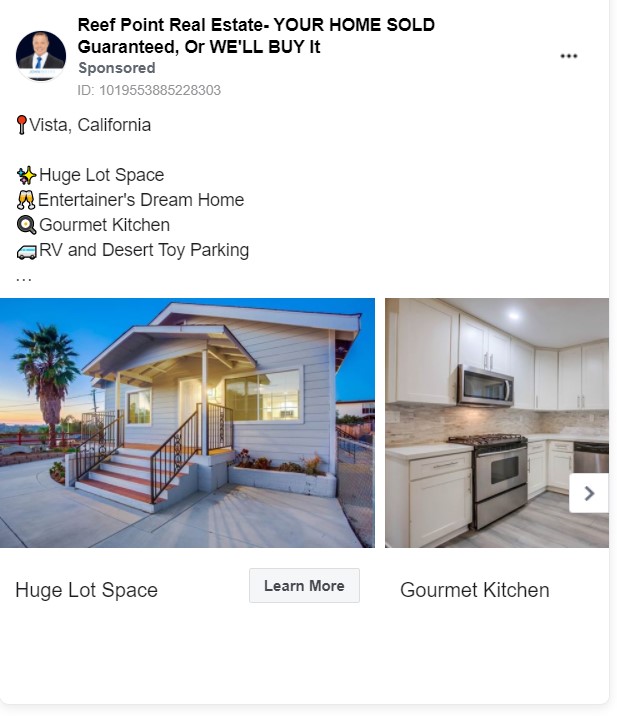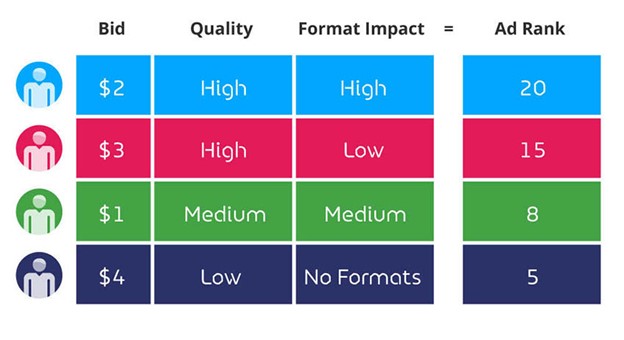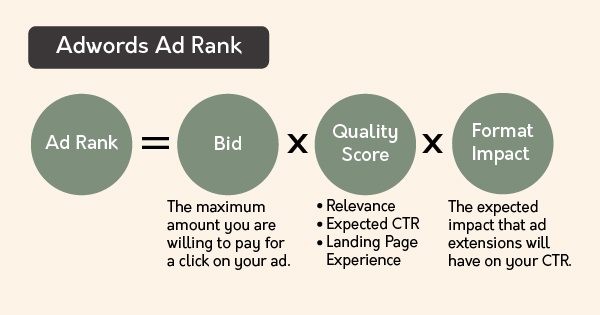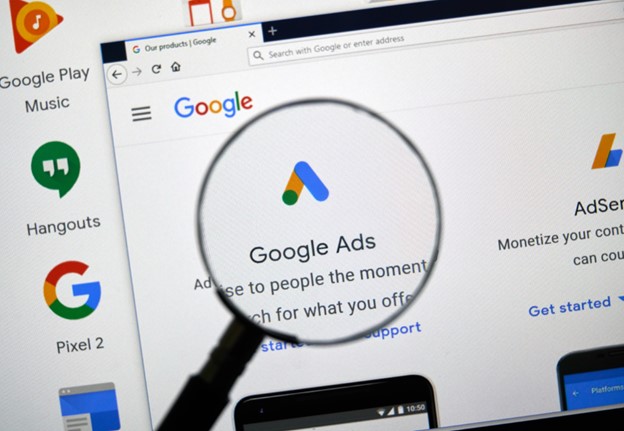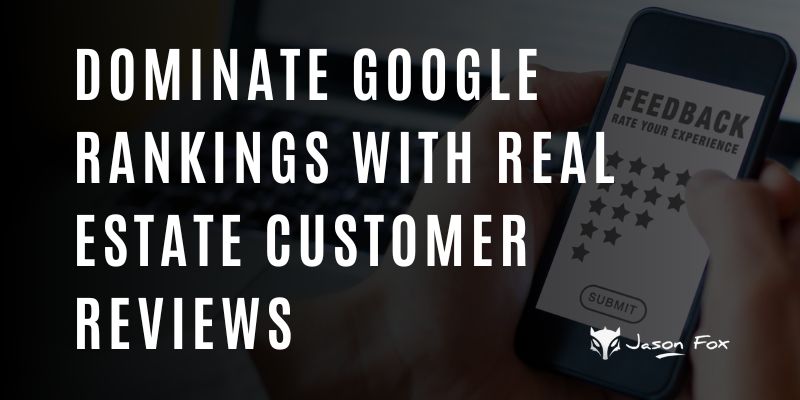13 Tried and Tested Google Ads Strategies for Real Estate
Pay Per Click (PPC) is one of the best ways to generate instant traffic to your real estate listing or website. You only need the right strategies to win.
In theory, there’s nothing more fascinating than advertising on the first page of Google — reaching consumers who are searching for a new home.
If you’re a realtor, a real estate professional, or a homeowner looking to attract the right buyers, Google Ads (formerly Google AdWords) is the most popular advertising platform, where you can feel confident with your ad spend.
To help you make money from your ads and maximize your ROI, here are 13 tried and tested Google Ads strategies that realtors can implement today:
1. Use Geo-targeting Feature to Reach the Right Buyers
The first Google Ads strategy you can execute today is geo-targeting. You can use the geo-targeting feature inside the Google Ads platform to solve the localization problem and prevent your ads from showing up in irrelevant locations.
Why advertise to Chicago residents when you’re more interested in reaching residents in Brooklyn? Here’s a great example:
Wondering how you can set up geo-targeting campaigns for your real estate ads?
Here’s a walkthrough to help you:
a. After logging into your Google Ads account, click on Location options. Then glance through the Target column and select People in, or who show interest in, your targeted locations. This setting will make your ad to become visible to only those people in the locations you have selected.
b. Next, select People in, or who show interest in, your targeted locations under the Exclude Column. Yes, these are the best settings to use. This will make your ad visible to people who might be interested in relocating within the same city plus those in your primary locations.
c. Finally, you want to set location bid adjustments. The goal is to increase the bid even as searches get closer to your targeted areas and decrease the bid as the searches move further away.
When you take advantage of this incremental bid adjustment, your real estate ad will be shown to more searchers closer to where your property is listed.
Pro tip: If you opened an office in a new location that you’re unfamiliar with, it’s important to learn how this audience communicates, their language, the slang they use, etc. there are online tutoring resources to guide you.
Remember that your ads will get better results if you learn what each word means, and how to best use them in your ad copy.
2. Use Negative Keywords to Filter Out Irrelevant Exposures
When you use negative keywords in your ads, you’re telling the Google Ads algorithm to avoid showing ads when such keywords are searched or typed into the Google search bar.
To give you an example, if you don’t want to target condo buyers, you can add “condo buyers” as a negative keyword. This will prevent your ad from showing when a potential homebuyer searches for a condo in your targeted areas or locations.
If you don’t want people looking for Airbnb homes or freelancers just looking for a place to rent for a few months, then you can filter that out as well.
For example, if you want to sell a property in Dover, New Jersey, then other locations should be negated.
I’m sure you wouldn’t want buyers in 20 different locations to see your ad. You already have thousands of people in Dover to reach, stay niched, and focused.
Note: Remember to ‘not include’ the target state or city in your negative keyword list. Cross-check and make sure your keywords have been carefully selected and sorted.
3. Bid for Top Ad Positions To Maximize Clicks
Ad Position shows the order of your real estate ad in the auction results with respect to other ads.
Ad Rank is the primary metric that Google calculates and uses other 5 factors to determine.
These factors include:
- Bid amount
- Ad Rank thresholds
- Quality Score
- The searcher intent
- The estimated impact of the ad extensions and ad formats your ad is based upon.
These Ad positions are based on the numbers 1 – 7. But the average ad positions can be reported based on decimals.
All things being equal, if your ad shows up at the top of the page (Ad position 1), it means you’ll get a high CTR (Click-through Rate) and a high CPC (Cost per Click).
You’ll often notice a clear difference in CPC between ad positions 1 – 1.4 and 1.8 – 3.4.
In a study by Hallam Internet, the most profitable average ad positions are 2.1, 3.5, or 4.6.
The goal with your bidding is to hit that sweet spot between CPC and CTR — so that could mean the #1 position or a bit down the Ad positions (perhaps #2 position).
Keep in mind that you’re going to use display banners with beautiful photos if you’re using Google Display Networks instead of search ads. So your ad copy also determines how much clicks your ad will get.
4. Focus On The Right Keyword Match Type for Real Estate PPC
Google Ads is a very flexible advertising platform. Real estate companies can easily select 1 out of 3 different match types for each target keyword they bid on:
- Broad
- Phrase
- Exact
Since Broad Match is mostly the default match type, many real estate professionals (especially beginners) stick to it. With broad match keywords selected, your ad will appear whenever a search phrase contains that keyword is used.
For example, if your ad targets the phrase “buy bungalow in NJ” and you select Broad Match, your ad most certainly will appear for searches related to “buy bungalow furniture in NJ”, “best NJ bungalow projects, or “buy apartment in NJ”.
Broad Match keywords will yield maximum exposure but you can’t count on the traffic — because it’d be low quality. This shouldn’t be the best match type for real estate professionals that want to get leads and clients. It’s like throwing money away.
Ideally, the best keyword match types that can help you make more money from your ads are the Phrase Match and Exact Match.
With the Phrase and Exact Match types, your keyword will only appear when the exact words or ‘intent’ phrases are searched.
For example, if your target keyword is ‘rent a condo in Chicago,” then your ad will not show up for “buy condo in Chicago” because they’re not the same and the searcher intent is different.
5. Tracking Your Conversions Early On
After a few days of running your real estate ads via the Google ads platform, it’s time to start tracking. Don’t wait until you have started making money before you set up the conversion tracking code.
Data is important. You want to know what percentage of users click your ad and what days generated the most clicks. Is your ad converting clicks to buyers?
Some real estate advertisers might get all excited when they see a high CTR on their ads. But when they set up and analyze their conversion tracking — they realize that ‘clicks’ don’t mean sales.
On the flip side, through tracking, you can also see an ad that has generated fewer clicks but higher conversions. That’s exactly what you want to see.
That’s why it’s very important to set up conversion tracking once you start running ads on Google. You can learn more from this conversion tracking guide.
6. Create An Ad Group for Each Type of House or Theme
To get the best results, it makes sense to create separate ad groups for different types of homes such as split-level, condo, tiny home, cabin, etc.
Perhaps you’re into themes such as luxury living and minimalist living, such themes also require a separate ad group. Here’s a well-illustrated visual from WordStream to guide you:
As an example, if you’re a commercial real estate professional in Los Angeles, California, your main target keyword is “commercial real estate agent”. This should trigger your ad to show up once searched.
You might even be targeting a specific type of businesses that need commercial property, maybe a restaurant, or even a manufacturing business that sells different types of empty capsules.
But what happens when a potential buyer enters “commercial real estate agent Santa Monica California”?
In this case, they’re probably searching for a house to buy in Santa Monica specifically.
If you didn’t create an ad group, it means you’ll not have property listings to cater to this potential buyer.
The potential ad that shows up was triggered by the search query — which may lead the prospect to suburban homes.
That’s why it’s important to create multiple ad groups — so that you can cater to different types of housing, giving room for specific keywords and ads to show up when the right buyers come looking for your listings.
7. Create Multiple Ad Copies That Are Keyword Based
The essence of running real estate ads is to target keywords that homebuyers are searching for in a specific location. Certainly, you’re not targeting the entire country or state, but specific locations (e.g., Dover).
Hence, it’s important to optimize multiple ad copies that are based around those specific keywords you want your property listings to show up for. These ad copies should also be relevant to your ad group.
Here are some of the easy ways to create multiple ads that get results:
- Highlight the benefits, and not just the features: How is the community where your property is located like? Is it conducive, commercial, or trendy? You could highlight its property in your ad to make it stand out from the rest (competitors).
- Use numbers in the copy: Using numbers instead of text means your ad can quickly draw people’s attention. Make sure you use numbers in your ad headline and expertise as well as how many properties have you sold so far.
- Create an eye-catching headline that matches the search query. Remember that users are always excited and drawn to click on an ad that clearly ‘speaks’ to them in person, addresses their situation, and promises to help them out.
8. Create Ad Extensions
There are 3 types of Ad extensions you can utilize to make your ads pop and get more clicks. Let’s talk about them:
1. Call extension: Smart real estate advertisers are using call extensions to boost click-through rates (CTR) and conversions. There’s a high rate of mobile phone usage today, which necessitates the use of call-specific extensions.
With a Call extension set up, your phone number will be displayed right on your ad, giving potential buyers the chance to directly call your office or mobile phone — without having to visit your website first, and then your contact page.
If you target mobile users, then you can integrate this extension with a predictive dialer to make the calls even more automated and result-driven.
According to a report by Google, 70% of searchers on mobile will call a business using a link from the search. So you’ll most likely increase your conversions if you use this extension. Don’t you think so?
Make sure your call extension is well set up with your business hours. You don’t want your prospects to call outside your office hours. A voicemail sucks, so minimize its use as much as possible.
2. Message extension: With this Ad Extension, your audience can click to text your real estate business directly from the search result page. Text messaging is still the ultimate way to reach a lot of local businesses today.
Almost any business that sells locally can use this extension. For example, eCommerce stores like Zappos, 3Wishes, and Etsy use this type of extension in their ads as well to target local consumers.
You can even create a pre-written or placeholder message to encourage conversion between you and the potential prospect.
3. Location extension: If you want users to know where your office is located, you can set up the location extension to guide them.
They just need to follow a few more simple steps such as finger tapping on their mobile phones or clicking a mouse on their desktop computer to find directions to your office. You can also simplify the process by using a map generator to show the directions.
Here’s a great Google ads campaign example from PDXPrime Realtors that use the location extension:
According to ComScore, 78% of location-based mobile searches lead to an offline purchase. No real estate company or professional would want to miss out on these leads by neglecting this extension!
9. Ad Spend and Conversions
As a real estate company or realtor, you must not run ads on Google blindly. Here’s what the average costs of Google ads as documented by AdEspresso:
Make sure you’re aware of how much you’re spending and what results you’re getting. Otherwise, you’ll soon run out of money and go back to square one (12).
Since selling real estate involves a lengthy sales cycle, you need to keep base with your spending. You also need to consistently acquire new leads that you can nurture and convert to buyers.
You can host webinars, give away eBooks, or create blog posts that engage with your leads and encourage them to consider buying from you.
While Google Ads is a great way to get consistent leads, you also want to prevent or minimize irrelevant clicks and attract only qualified leads.
This is such an important consideration, because if you’re on vacation and just need to rest and enjoy sleep in order to stay refreshed, you don’t want to come back to a failed ad.
So you should spend an adequate amount of time on your ads’ analytics. Also, invest in improving your knowledge of Google Ads. It’s a data-driven advertising platform — that combines science and art.
You’ll definitely lose more money than you make in the long run if you’re naïve. Pay attention to details and always ask “why” instead of “what” when running Google ad campaigns for your property listing.
10. Create High-Converting Landing Page For Your Campaigns
No two properties or apartments are exactly the same. Thus, it doesn’t make sense to use the same or one landing page to power them.
The rule of thumb is to create a separate and relevant landing page for each campaign.
You can create one from scratch by getting a web hosting from Bluehost or simply use builders like Instapage, Unbounce, or Clickfunnels to design from a professional template.
When you’re ready to sell a condo, don’t use the same landing page for bungalow buyers to ‘attempt’ to convert new buyers.
It’s a waste of time and ad spend. Because it’ll not work.
The purpose of a high-converting landing page is to provide value to your users without confusing them.
If you’re selling a tiny home, for example, then focus on that language and everything that concerns tiny homes. Don’t emphasize family apartments or how awesome your condo is close to a restaurant that provides the perfect meal plan, etc.
The offer on your landing page, headline, and theme (including color) must be relevant to the ad copy if you want the clicks to result in conversions. This is known as a “message match.”
11. Use Brand Name In The Ads’ Headlines
Buying a home is a huge financial investment for most people. While it’s important to protect your online privacy, you don’t have to hide your brand.
Here’s an example:
Bring it to the spotlight with your ad headline!
Beyond bidding on your target keywords, it’s important to also include your real estate agency’s brand name in the headline. This is especially important if you’re a well-known brand in the industry.
You can implement this strategy by writing at least three different ads for each ad group in your Google Ads campaign. Then add your brand name in one of the ads.
Although a lot of people skip ads that appear at the top of search results, which means you’ll not get clicks to your real estate website.
But if you include your brand name in the ad copy headline, it means you’re advertising it as well. So with or without a click, your brand will get some exposure — so that potential buyers can even search for the brand name when they’re ready to buy a home.
12. Ranking Number #1 May Not Be The Best Position for ROI
Your bid amount is a key factor that determines where your ad is shown (the position) in search results. So if you have 5 advertisers bidding for “houses for sale in Chicago” and your bid is the highest, your ad will appear at the top.
But don’t be tempted to retain that #1 position by increasing your bid amounts. You don’t have to covet that #1 position if you can get better or similar results with positions #2 and #3.
If you keep pushing for the first position, you’ll blindly increase your advertising cost substantially. In worst case scenarios, you may start getting low converting clicks.
The rule of thumb is to continually change your ad’s position by carefully adjusting your bid amount. Then you can make better decisions based on the ad positions to produce a higher conversion rate.
13. Pay Attention To Google’s New Policy For Housing-related Ads
This is both a strategy and a caution.
The real estate industry is regulated. When you’re spending money on ads, it’s important to know what Google wants and the best practices to adopt on your housing-related ads.
Your ads must be compliant and adhere to the latest Google Ads guidelines.
One of these guidelines is probably the fact that it prohibits real estate professionals, lenders, and investors in the U.S. and Canada from using certain targeting options such as demographics and zip code.
If you didn’t know that before, now you do. You can get the full policy guidelines directly from Google here.
Conclusion
There’s no better time to use Google ads to get leads and buyers for your real estate listings.
Real estate is a competitive industry. So you need a consistent flow of quality leads that you can convert to buyers.
No need to spend months and years trying to get free traffic from social media and organic search results. Use Google Ads to level up and grow your real estate business.
I’d love to hear from you. Which of these Google Ads strategies have you implemented in your real estate ad campaign?
post contents
Pay Per Click (PPC) is one of the best ways to generate instant traffic to your real estate listing or website. You only need the right strategies to win.
In theory, there’s nothing more fascinating than advertising on the first page of Google — reaching consumers who are searching for a new home.
If you’re a realtor, a real estate professional, or a homeowner looking to attract the right buyers, Google Ads (formerly Google AdWords) is the most popular advertising platform, where you can feel confident with your ad spend.
To help you make money from your ads and maximize your ROI, here are 13 tried and tested Google Ads strategies that realtors can implement today:
1. Use Geo-targeting Feature to Reach the Right Buyers
The first Google Ads strategy you can execute today is geo-targeting. You can use the geo-targeting feature inside the Google Ads platform to solve the localization problem and prevent your ads from showing up in irrelevant locations.
Why advertise to Chicago residents when you’re more interested in reaching residents in Brooklyn? Here’s a great example:
Wondering how you can set up geo-targeting campaigns for your real estate ads?
Here’s a walkthrough to help you:
a. After logging into your Google Ads account, click on Location options. Then glance through the Target column and select People in, or who show interest in, your targeted locations. This setting will make your ad to become visible to only those people in the locations you have selected.
b. Next, select People in, or who show interest in, your targeted locations under the Exclude Column. Yes, these are the best settings to use. This will make your ad visible to people who might be interested in relocating within the same city plus those in your primary locations.
c. Finally, you want to set location bid adjustments. The goal is to increase the bid even as searches get closer to your targeted areas and decrease the bid as the searches move further away.
When you take advantage of this incremental bid adjustment, your real estate ad will be shown to more searchers closer to where your property is listed.
Pro tip: If you opened an office in a new location that you’re unfamiliar with, it’s important to learn how this audience communicates, their language, the slang they use, etc. there are online tutoring resources to guide you.
Remember that your ads will get better results if you learn what each word means, and how to best use them in your ad copy.
2. Use Negative Keywords to Filter Out Irrelevant Exposures
When you use negative keywords in your ads, you’re telling the Google Ads algorithm to avoid showing ads when such keywords are searched or typed into the Google search bar.
To give you an example, if you don’t want to target condo buyers, you can add “condo buyers” as a negative keyword. This will prevent your ad from showing when a potential homebuyer searches for a condo in your targeted areas or locations.
If you don’t want people looking for Airbnb homes or freelancers just looking for a place to rent for a few months, then you can filter that out as well.
For example, if you want to sell a property in Dover, New Jersey, then other locations should be negated.
I’m sure you wouldn’t want buyers in 20 different locations to see your ad. You already have thousands of people in Dover to reach, stay niched, and focused.
Note: Remember to ‘not include’ the target state or city in your negative keyword list. Cross-check and make sure your keywords have been carefully selected and sorted.
3. Bid for Top Ad Positions To Maximize Clicks
Ad Position shows the order of your real estate ad in the auction results with respect to other ads.
Ad Rank is the primary metric that Google calculates and uses other 5 factors to determine.
These factors include:
- Bid amount
- Ad Rank thresholds
- Quality Score
- The searcher intent
- The estimated impact of the ad extensions and ad formats your ad is based upon.
These Ad positions are based on the numbers 1 – 7. But the average ad positions can be reported based on decimals.
All things being equal, if your ad shows up at the top of the page (Ad position 1), it means you’ll get a high CTR (Click-through Rate) and a high CPC (Cost per Click).
You’ll often notice a clear difference in CPC between ad positions 1 – 1.4 and 1.8 – 3.4.
In a study by Hallam Internet, the most profitable average ad positions are 2.1, 3.5, or 4.6.
The goal with your bidding is to hit that sweet spot between CPC and CTR — so that could mean the #1 position or a bit down the Ad positions (perhaps #2 position).
Keep in mind that you’re going to use display banners with beautiful photos if you’re using Google Display Networks instead of search ads. So your ad copy also determines how much clicks your ad will get.
4. Focus On The Right Keyword Match Type for Real Estate PPC
Google Ads is a very flexible advertising platform. Real estate companies can easily select 1 out of 3 different match types for each target keyword they bid on:
- Broad
- Phrase
- Exact
Since Broad Match is mostly the default match type, many real estate professionals (especially beginners) stick to it. With broad match keywords selected, your ad will appear whenever a search phrase contains that keyword is used.
For example, if your ad targets the phrase “buy bungalow in NJ” and you select Broad Match, your ad most certainly will appear for searches related to “buy bungalow furniture in NJ”, “best NJ bungalow projects, or “buy apartment in NJ”.
Broad Match keywords will yield maximum exposure but you can’t count on the traffic — because it’d be low quality. This shouldn’t be the best match type for real estate professionals that want to get leads and clients. It’s like throwing money away.
Ideally, the best keyword match types that can help you make more money from your ads are the Phrase Match and Exact Match.
With the Phrase and Exact Match types, your keyword will only appear when the exact words or ‘intent’ phrases are searched.
For example, if your target keyword is ‘rent a condo in Chicago,” then your ad will not show up for “buy condo in Chicago” because they’re not the same and the searcher intent is different.
5. Tracking Your Conversions Early On
After a few days of running your real estate ads via the Google ads platform, it’s time to start tracking. Don’t wait until you have started making money before you set up the conversion tracking code.
Data is important. You want to know what percentage of users click your ad and what days generated the most clicks. Is your ad converting clicks to buyers?
Some real estate advertisers might get all excited when they see a high CTR on their ads. But when they set up and analyze their conversion tracking — they realize that ‘clicks’ don’t mean sales.
On the flip side, through tracking, you can also see an ad that has generated fewer clicks but higher conversions. That’s exactly what you want to see.
That’s why it’s very important to set up conversion tracking once you start running ads on Google. You can learn more from this conversion tracking guide.
6. Create An Ad Group for Each Type of House or Theme
To get the best results, it makes sense to create separate ad groups for different types of homes such as split-level, condo, tiny home, cabin, etc.
Perhaps you’re into themes such as luxury living and minimalist living, such themes also require a separate ad group. Here’s a well-illustrated visual from WordStream to guide you:
As an example, if you’re a commercial real estate professional in Los Angeles, California, your main target keyword is “commercial real estate agent”. This should trigger your ad to show up once searched.
You might even be targeting a specific type of businesses that need commercial property, maybe a restaurant, or even a manufacturing business that sells different types of empty capsules.
But what happens when a potential buyer enters “commercial real estate agent Santa Monica California”?
In this case, they’re probably searching for a house to buy in Santa Monica specifically.
If you didn’t create an ad group, it means you’ll not have property listings to cater to this potential buyer.
The potential ad that shows up was triggered by the search query — which may lead the prospect to suburban homes.
That’s why it’s important to create multiple ad groups — so that you can cater to different types of housing, giving room for specific keywords and ads to show up when the right buyers come looking for your listings.
7. Create Multiple Ad Copies That Are Keyword Based
The essence of running real estate ads is to target keywords that homebuyers are searching for in a specific location. Certainly, you’re not targeting the entire country or state, but specific locations (e.g., Dover).
Hence, it’s important to optimize multiple ad copies that are based around those specific keywords you want your property listings to show up for. These ad copies should also be relevant to your ad group.
Here are some of the easy ways to create multiple ads that get results:
- Highlight the benefits, and not just the features: How is the community where your property is located like? Is it conducive, commercial, or trendy? You could highlight its property in your ad to make it stand out from the rest (competitors).
- Use numbers in the copy: Using numbers instead of text means your ad can quickly draw people’s attention. Make sure you use numbers in your ad headline and expertise as well as how many properties have you sold so far.
- Create an eye-catching headline that matches the search query. Remember that users are always excited and drawn to click on an ad that clearly ‘speaks’ to them in person, addresses their situation, and promises to help them out.
8. Create Ad Extensions
There are 3 types of Ad extensions you can utilize to make your ads pop and get more clicks. Let’s talk about them:
1. Call extension: Smart real estate advertisers are using call extensions to boost click-through rates (CTR) and conversions. There’s a high rate of mobile phone usage today, which necessitates the use of call-specific extensions.
With a Call extension set up, your phone number will be displayed right on your ad, giving potential buyers the chance to directly call your office or mobile phone — without having to visit your website first, and then your contact page.
If you target mobile users, then you can integrate this extension with a predictive dialer to make the calls even more automated and result-driven.
According to a report by Google, 70% of searchers on mobile will call a business using a link from the search. So you’ll most likely increase your conversions if you use this extension. Don’t you think so?
Make sure your call extension is well set up with your business hours. You don’t want your prospects to call outside your office hours. A voicemail sucks, so minimize its use as much as possible.
2. Message extension: With this Ad Extension, your audience can click to text your real estate business directly from the search result page. Text messaging is still the ultimate way to reach a lot of local businesses today.
Almost any business that sells locally can use this extension. For example, eCommerce stores like Zappos, 3Wishes, and Etsy use this type of extension in their ads as well to target local consumers.
You can even create a pre-written or placeholder message to encourage conversion between you and the potential prospect.
3. Location extension: If you want users to know where your office is located, you can set up the location extension to guide them.
They just need to follow a few more simple steps such as finger tapping on their mobile phones or clicking a mouse on their desktop computer to find directions to your office. You can also simplify the process by using a map generator to show the directions.
Here’s a great Google ads campaign example from PDXPrime Realtors that use the location extension:
According to ComScore, 78% of location-based mobile searches lead to an offline purchase. No real estate company or professional would want to miss out on these leads by neglecting this extension!
9. Ad Spend and Conversions
As a real estate company or realtor, you must not run ads on Google blindly. Here’s what the average costs of Google ads as documented by AdEspresso:
Make sure you’re aware of how much you’re spending and what results you’re getting. Otherwise, you’ll soon run out of money and go back to square one (12).
Since selling real estate involves a lengthy sales cycle, you need to keep base with your spending. You also need to consistently acquire new leads that you can nurture and convert to buyers.
You can host webinars, give away eBooks, or create blog posts that engage with your leads and encourage them to consider buying from you.
While Google Ads is a great way to get consistent leads, you also want to prevent or minimize irrelevant clicks and attract only qualified leads.
This is such an important consideration, because if you’re on vacation and just need to rest and enjoy sleep in order to stay refreshed, you don’t want to come back to a failed ad.
So you should spend an adequate amount of time on your ads’ analytics. Also, invest in improving your knowledge of Google Ads. It’s a data-driven advertising platform — that combines science and art.
You’ll definitely lose more money than you make in the long run if you’re naïve. Pay attention to details and always ask “why” instead of “what” when running Google ad campaigns for your property listing.
10. Create High-Converting Landing Page For Your Campaigns
No two properties or apartments are exactly the same. Thus, it doesn’t make sense to use the same or one landing page to power them.
The rule of thumb is to create a separate and relevant landing page for each campaign.
You can create one from scratch by getting a web hosting from Bluehost or simply use builders like Instapage, Unbounce, or Clickfunnels to design from a professional template.
When you’re ready to sell a condo, don’t use the same landing page for bungalow buyers to ‘attempt’ to convert new buyers.
It’s a waste of time and ad spend. Because it’ll not work.
The purpose of a high-converting landing page is to provide value to your users without confusing them.
If you’re selling a tiny home, for example, then focus on that language and everything that concerns tiny homes. Don’t emphasize family apartments or how awesome your condo is close to a restaurant that provides the perfect meal plan, etc.
The offer on your landing page, headline, and theme (including color) must be relevant to the ad copy if you want the clicks to result in conversions. This is known as a “message match.”
11. Use Brand Name In The Ads’ Headlines
Buying a home is a huge financial investment for most people. While it’s important to protect your online privacy, you don’t have to hide your brand.
Here’s an example:
Bring it to the spotlight with your ad headline!
Beyond bidding on your target keywords, it’s important to also include your real estate agency’s brand name in the headline. This is especially important if you’re a well-known brand in the industry.
You can implement this strategy by writing at least three different ads for each ad group in your Google Ads campaign. Then add your brand name in one of the ads.
Although a lot of people skip ads that appear at the top of search results, which means you’ll not get clicks to your real estate website.
But if you include your brand name in the ad copy headline, it means you’re advertising it as well. So with or without a click, your brand will get some exposure — so that potential buyers can even search for the brand name when they’re ready to buy a home.
12. Ranking Number #1 May Not Be The Best Position for ROI
Your bid amount is a key factor that determines where your ad is shown (the position) in search results. So if you have 5 advertisers bidding for “houses for sale in Chicago” and your bid is the highest, your ad will appear at the top.
But don’t be tempted to retain that #1 position by increasing your bid amounts. You don’t have to covet that #1 position if you can get better or similar results with positions #2 and #3.
If you keep pushing for the first position, you’ll blindly increase your advertising cost substantially. In worst case scenarios, you may start getting low converting clicks.
The rule of thumb is to continually change your ad’s position by carefully adjusting your bid amount. Then you can make better decisions based on the ad positions to produce a higher conversion rate.
13. Pay Attention To Google’s New Policy For Housing-related Ads
This is both a strategy and a caution.
The real estate industry is regulated. When you’re spending money on ads, it’s important to know what Google wants and the best practices to adopt on your housing-related ads.
Your ads must be compliant and adhere to the latest Google Ads guidelines.
One of these guidelines is probably the fact that it prohibits real estate professionals, lenders, and investors in the U.S. and Canada from using certain targeting options such as demographics and zip code.
If you didn’t know that before, now you do. You can get the full policy guidelines directly from Google here.
Conclusion
There’s no better time to use Google ads to get leads and buyers for your real estate listings.
Real estate is a competitive industry. So you need a consistent flow of quality leads that you can convert to buyers.
No need to spend months and years trying to get free traffic from social media and organic search results. Use Google Ads to level up and grow your real estate business.
I’d love to hear from you. Which of these Google Ads strategies have you implemented in your real estate ad campaign?
Latest articles
First-time homebuyers are probably eager to find their forever home in the housing market. However, there’s plenty of mystery behind the buying landscape, how to purchase and other considerations they should make.
Unlock the potential of content marketing in real estate with actionable strategies designed to boost your online presence and engage clients effectively.
The Importance of Google Rankings for Real Estate Agents Over the past fifteen years, I’ve seen how a good Google ranking can make or break a real estate business. Higher rankings mean more people seeing
BECOME A MEMBER
Become A Free DIY Real Estate Marketing Member & Get Access To:
LARGEST COLLECTION OF
Real Estate Marketing e-Books, Guides, Templates, & whitepapers
ON THE INTERNET
+ OVER 70 How To Website Training Videos including; WordPress, Agent Evolution Themes, & IDX Broker
+ DIY Real Estate Marketing Tips and Strategies Delivered to Your Inbox
Share this article
recent posts

Written by : Burkhard Berger
Burkhard Berger is the founder of awesomex™. You can follow him on his journey from 0 to 100,000 monthly visitors on <a href="https://www.awesomex.com/" target="_blank">www.awesomex.com</a>. His articles include some of the best growth hacking strategies and digital scaling tactics that he has learned from his own successes and failures.


